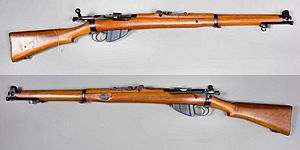Lee–Enfield facts for kids
The Lee–Enfield is a famous type of bolt-action rifle. It was the main firearm used by the armies of the British Empire and Commonwealth countries for a long time, especially in the first half of the 1900s. The British Army officially used it from 1895 until 1957.
This rifle gets its name from two things: James Paris Lee, who designed its special bolt system, and the Royal Small Arms Factory in Enfield, where its barrel design was made.
Quick facts for kids Lee–Enfield |
|
|---|---|

Short Magazine Lee–Enfield Mk I (1903), Swedish Army Museum, Stockholm
|
|
| Type | Bolt-action rifle |
| Place of origin | United Kingdom |
| Service history | |
| In service |
|
| Used by | See Users |
| Wars |
List
Second Boer War
World War I Easter Rising Various colonial conflicts Polish-Soviet War Jallianwala Bagh Massacre Irish War of Independence Irish Civil War Constitutionalist Revolution(Limited) Spanish Civil War World War II Indonesian National Revolution Indo-Pakistani Wars Greek Civil War Malayan Emergency French Indochina War Korean War 1948 Arab–Israeli War Border Campaign (Irish Republican Army) Mau Mau Uprising Suez Crisis Algerian War Portuguese Colonial War Congo Crisis Battle of Mengo Hill Nathu La and Cho La clashes Nigerian Civil War Vietnam War Rhodesian Bush War Cypriot intercommunal violence The Troubles Sino-Indian War Dhofar Rebellion Zanzibar Revolution Chadian Civil War Bangladesh Liberation War Turkish invasion of Cyprus Uganda–Tanzania War Soviet–Afghan War Nepalese Civil War Afghanistan conflict Iraq War |
| Production history | |
| Designer | James Paris Lee, RSAF Enfield |
| Produced |
|
| No. built | 17,000,000+ |
| Variants | See Models/marks |
| Specifications | |
| Mass |
|
| Length |
|
| Barrel length |
|
|
|
|
| Cartridge | .303 Mk VII SAA Ball |
| Action | Bolt-action |
| Rate of fire | 20–30 aimed shots per minute |
| Muzzle velocity | 2,441 ft/s (744 m/s) |
| Effective firing range | 550 yd (503 m) |
| Maximum firing range | 3,000 yd (2,743 m) |
| Feed system | 10-round magazine, loaded with 5-round charger clips |
| Sights | Sliding ramp rear sights, fixed-post front sights, "dial" long-range volley; telescopic sights on sniper models. Fixed and adjustable aperture sights incorporated onto later variants |
What is a Lee–Enfield Rifle?
The Lee–Enfield is a type of repeating rifle. This means it can fire multiple shots without needing to be reloaded after each shot. It uses a magazine that holds ten rounds of .303 British ammunition. Soldiers could load this magazine either one bullet at a time or using special clips that held five bullets.
The Lee–Enfield was an improved version of an older rifle called the Lee–Metford. It took the place of several older rifles used by the British Army.
A Rifle for Two World Wars
The Lee–Enfield was a very important weapon during the First World War and the Second World War. It was given to soldiers in the British Army and other armies in the Commonwealth, like those from Australia, New Zealand, South Africa, and Canada.
During World War I, the versions of this rifle were often called the "SMLE." This stands for "Short, Magazine, Lee–Enfield," which was a very common type.
A Long History of Service
Even though the United Kingdom officially replaced the Lee–Enfield with a new rifle in 1957, it was still widely used by British forces until the mid-1960s. Special sniper versions of the rifle were even used until the 1990s!
Today, the Lee–Enfield is still used by the armed forces in some Commonwealth countries, for example, by the police in Bangladesh. This makes it one of the longest-serving bolt-action rifles still in official use. More than 17 million Lee–Enfield rifles have been made in total.
See also
 In Spanish: Lee-Enfield para niños
In Spanish: Lee-Enfield para niños

